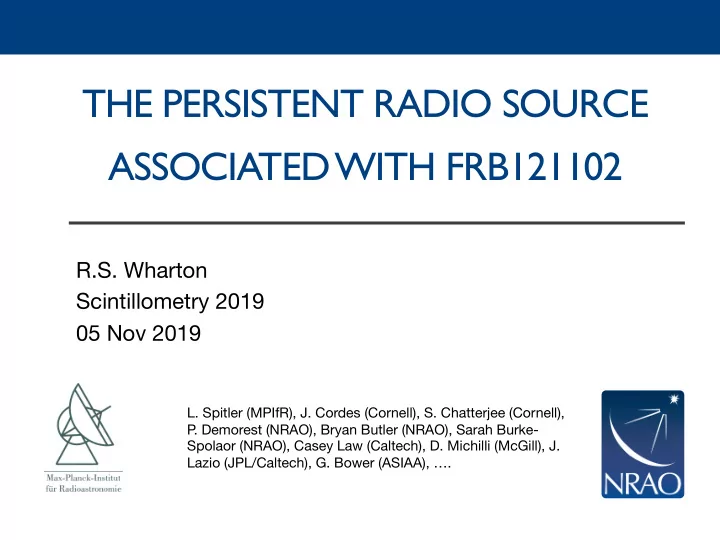

THE PERSISTENT RADIO SOURCE ASSOCIATED WITH FRB121102 R.S. Wharton Scintillometry 2019 05 Nov 2019 L. Spitler (MPIfR), J. Cordes (Cornell), S. Chatterjee (Cornell), P . Demorest (NRAO), Bryan Butler (NRAO), Sarah Burke- Spolaor (NRAO), Casey Law (Caltech), D. Michilli (McGill), J. Lazio (JPL/Caltech), G. Bower (ASIAA), ….
What are FRBs? Two Main Strategies: 1) Population Statistics 2) Localization
Arcsecond Localizations Chatterjee et al. (2017) What Do We Get? FRB 121102 Redshift • Galaxy Mass • Galaxy Star Formation Rate • Image from: Bassa et al. (2017) Prochaska et al. (2019) Ravi et al. (2019) Bannister et al. (2019) FRB 190523 FRB 181112 FRB 180924
FRB 121102 First Arecibo FRB – Kind of interesting! First Repeating FRB –VERY interesting! Excellent Target for Localization
FRB 121102 Δ𝜄 ≈ 100 mas More Info: realfast.io
FRB 121102 “Persistent Radio Source” VLA 3 GHz 12:00 𝑇 ≈ 200 𝜈Jy at 3 GHz • • Compact on mas scales • Some (~10%) variability +33:09:00 Optical Counterpart Gemini r-band • T endulkar et al. (2017) • Dwarf Galaxy 06:00 𝑨 = 0.193 𝐸 5 = 972 Mpc • 𝑁 ∗ ∼ 10 = 𝑁 ⊙ • 𝑇𝐺𝑆 ≈ 0.4𝑁 ⊙ yr CD • 12 5:32:00 48 31:36
FRB 121102 Host Galaxy HST Imaging (Bassa et al. 2017) Offset Star Forming Region Low Metallicity 1′′ Similar to SLSNe and LGRBs? Adapted from Bassa et al. (2017)
FRB 121102 Marcote et al. (2017) 12 mas = 40 pc EVN Imaging 𝜄 ≤ 0.7 pc (0.2 mas at 5 GHz) • 𝜄 ∼ 2 − 4 mas at 1.7 GHz • Burst – PRS Separation • EVN+Arecibo 1.7 GHz • Detected 4 bursts Δ𝜄 ≤ 12 mas ( Δ𝑦 ≤ 40 pc ) • Adapted from Marcote et al. (2017) PRS smaller than 1 pc and coincident with FRB to 40 pc (projected)!
FRB 121102 Michilli et al. (2018) Measured burst RMs Found RM ∼ +10 R rad m CT Burst source resides in an extreme magneto-ionic environment Michilli et al. (2018)
Models FRB Source Persistent Radio Source Magnetized Plasma Magnetar Galactic Center Galactic Center Nebula (unrelated) (related) Piro (2016) Eatough et al. (2013) Zhang (2018) Metzger et al. (2017) Desvignes et al. (2018) Vieyro et al. (2017) Margalit & Metzger (2018) Katz (2017) + more
What is the PRS? How do we differentiate models? 1) Time Evolution of Burst Properties (RM, DM, …) 2) Time Evolution of PRS Properties (flux, spectra) 3) Measure RM of PRS 4) Measure size of PRS or separation with FRB
Time Evolution of Rotation Measure Nebula – Margalit & Metzger (2018) GC Magnetar – Desvignes et al. (2018)
Time Evolution of Rotation Measure Nebula – Margalit & Metzger (2018) GC Magnetar – Desvignes et al. (2018) Burst RMs Decrease by ~30% L. Spitler, D. Michilli, J. Hessels, A. Seymour, G. Hilmarsson
Time Evolution of Dispersion Measure Nebula – Margalit & Metzger (2018) GC Magnetar – Desvignes et al. (2018)
Time Evolution of Dispersion Measure Nebula – Margalit & Metzger (2018) GC Magnetar – Desvignes et al. (2018) Burst DMs Increases (!) by ~1% L. Spitler, D. Michilli, J. Hessels, A. Seymour, G. Hilmarsson
Time Evolution of PRS Flux Density Nebula – Margalit & Metzger (2018) Sgr A* – Macquart & Bower (2006)
Time Evolution of PRS Flux Density Nebula – Margalit & Metzger (2018) Sgr A* – Macquart & Bower (2006) VLA 3 GHz Variability ~10% 80+ hours over 2 years New Obs Soon. Will get to 4 year baseline
Time Evolution of PRS Spectrum Measured spectrum from 1-20 GHz on 3 epochs Δ𝑢 = 3 days Δ𝑢 ≈ 460 days Broadly Consistent Bryan Butler, Sarah Burke-Spolaor, Shami Chatterjee, Jim Cordes, Paul Demorest, Joe Lazio, +
Measure RM of PRS Want to measure very large RM ( 10 W rad m CT ) in pretty faint source ( ∼ 100 𝜈Jy ) Need linear pol’n of >3% VLA from 8-12 GHz 4 x 5 hr obs (3 consecutive) Work in Progress …
Measure Size? Margalit & Metzger (2018)
Models FRB Source Persistent Radio Source Magnetized Plasma Magnetar Galactic Center Galactic Center Nebula (unrelated) (related) Piro (2016) Eatough et al. (2013) Zhang (2018) Metzger et al. (2017) Desvignes et al. (2018) Vieyro et al. (2017) Margalit & Metzger (2018) Katz (2017) + more
Thanks! 07:00 08:00 09:00 33:10:00 11:00 10 05 5:32:00 55 31:50
Recommend
More recommend